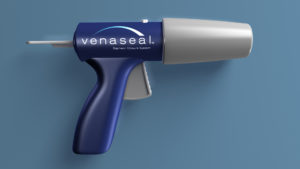Laser Vein Removal
Traditionally, patients with varicose veins were recommended conservative treatment options. Conservative treatment refers to a non-invasive form of treatment, where medication and surgery are not used to treat. Patients can make lifestyle changes, such as dieting, exercising, and wearing compression stockings. This regimen has proven helpful in reducing leg pain and further deterioration of the venous system. Conservative treatment will not remove existing vein disease, but it may be helpful in impeding further progression with patients who may not be able to undergo other treatment methods.
Endovenous Laser Treatment (EVLT Cost)
Endovenous laser treatment (EVLT) is a minimally invasive alternative to surgical stripping used to treat damaged veins quickly and effectively.
Before the EVLT procedure, the damaged vein path is mapped out using ultrasound. The procedure itself begins after the patient is placed under oral sedation and the leg area is numbed using a local anesthetic. A small insertion is made in the leg, usually around the knee. A catheter is then used to insert laser fiber into the varicose vein.
Using a targeted beam of laser energy, the diseased vein is quickly and safely sealed shut, diverting blood flow to the surrounding, healthy veins.
The procedure usually takes about an hour. You will be encouraged to walk around a bit immediately afterwards to get your blood flowing and reduce the risk of complications. Some bruising and swelling may occur, but these conditions are alleviated with the proper use of bandages and compression stockings for one to two weeks after the procedure.
Endovenous laser treatment has a 93% success rate and patients typically resume normal activities within one day, for more information on EVLT cost and treatment options, call our office today.
Microphlebectomy
Microphlebectomy is an outpatient medical procedure used to treat painful, unattractive varicosities that are located close to the skins surface. This procedure is ideal for veins that are too large to treat with sclerotherapy and too small to successfully treat with Radiofrequency. Microphlebectomy uses a series of tiny incisions to remove portions of the vein which are malfunctioning, causing pain and unsightly bulging. Because the vein is removed, the result is immediate and reoccurrence unlikely. This is also done under local anesthetic in the office and sometimes used in conjunction with Radiofrequency ablation of the saphenous veins. Most individuals are able to return to their normal activities immediately following the procedure. Daily walking is recommended, although strenuous activities should be avoided for 5-7 days.
Microphlebectomy Instructions
Before & After






Radiofrequency Ablation (VNUS closure)
During the VNUS Closure™ procedure, the patient is placed under oral sedation. A small, sterile catheter is inserted into the diseased vein. Using radiofrequency ablation, the catheter quickly heats the vein, causing it to collapse and seal shut. The blood flow is redirected to the remaining, healthy veins. The procedure is performed in segments, and is usually completed in only a few minutes.
Following the procedure, a bandage is placed on the insertion site, and a compression stocking is used to aid healing. You may be encouraged to refrain from strenuous activity for a period of time. Most patients resume normal activities within one day.
Most patients report minimal to no scarring, bruising or swelling. A study on post-closure patients who remained free of venous reflux for one year revealed that 92% were still reflux-free after five years.
Instructions
Before & After






VenaSeal™ Closure System
The VenaSeal™ closure system is the only non-tumescent, non-thermal, non-sclerosant procedure that uses a proprietary medical adhesive delivered endovenously to close the vein. This unique approach eliminates the risk of thermal nerve injury when treating the small saphenous vein, which is a risk sometimes associated with certain thermal-based procedures.1,2 Clinical studies have demonstrated that the procedure is safe and effective.3,4 The procedure is administered without the use of tumescent anesthesia, avoiding patient discomfort associated with multiple needle sticks.
- Improves blood flow by sealing – or closing – the diseased vein.
- Delivers a small amount of specially formulated medical adhesive to the diseased vein
- Seals the vein with adhesive and blood is rerouted through nearby veins
- Rapid return to normal activities
- Non-tumescent treatment – no multiple needle sticks
- Minimal-to-no bruising
- No post-procedure compression stockingsd






